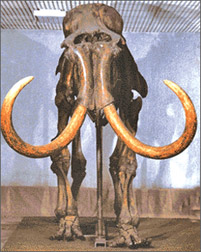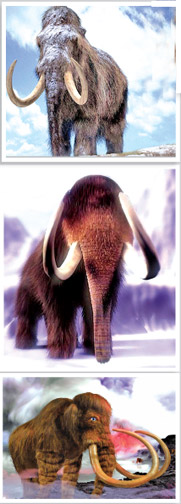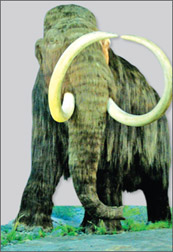|

Scientists are confident
they can perform this mammoth feat:
|

Skeleton of a wooly mammoth
|
 Will
the wooly mammoth which is now extinct walk the Earth once more, taking
the limelight away from the Asian and African elephants - the largest
animals on land at present? According to scientists, it is a strong
possibility. In about another five years or so, they claim they could
clone a wooly mammoth. Those of you who read the article titled 'Wooly
mammoths may roam again' which appeared in last week's Junior Observer
may already be pondering over the news. Even though the scientist, Prof.
Akira Iritani of Japan and a team of Russians who are researching into
this at present, are highly excited about the outcome, many are
sceptical about bringing back to life this massive creature which died
out over 10,000 years ago. Will
the wooly mammoth which is now extinct walk the Earth once more, taking
the limelight away from the Asian and African elephants - the largest
animals on land at present? According to scientists, it is a strong
possibility. In about another five years or so, they claim they could
clone a wooly mammoth. Those of you who read the article titled 'Wooly
mammoths may roam again' which appeared in last week's Junior Observer
may already be pondering over the news. Even though the scientist, Prof.
Akira Iritani of Japan and a team of Russians who are researching into
this at present, are highly excited about the outcome, many are
sceptical about bringing back to life this massive creature which died
out over 10,000 years ago.
Most people have expressed concern over the possibility of these
creatures eventually increasing in numbers, and the impact they would
have on other animal species including humans. Some critics warn it
would end up like 'Jurassic Park', as wooly mammoths are recorded to be
vicious and powerful creatures which attacked other animals when they
were alive. It is believed that even bullets may not be enough to stop
them if the mammoth population gets out of hand, because, this species
has the ability to reproduce fast.
This massive extinct creature is back in the limelight once again,
after managing to do so earlier too being featured in the popular movie
'Ice Age', earlier. So, let's checkout some interesting facts about
wooly mammoths that we are likely to see in the near future, if the
cloning techniques that have already been perfected become fruitful -
with an Asian or African elephant giving birth to one.
Wooly mammoths are prehistoric creatures like the dinosaurs and are
known in the modern world only by fossils. It was originally believed
that wooly mammoths disappeared from Europe and southern Siberia about
10,000 BC. However, recent findings show evidence of their presence even
around 8,000 BC. Wooly mammoths as well as Coloumbian mammoths had
disappeared from the North American Continent at the end of the last ice
age. A dwarf variety of wooly mammoths are recorded to have lived in
small herds on St. Pauls Island in Alaska until 3,750 BC and another
small group on Wrangel Island located in the Arctic Ocean, until 1700
BC.
Most wooly mammoths died at the end of the Pleistocene due to climate
change and hunting pressure. According to available fossils, the wooly
mammoth is not much taller than the African elephant, but it's much
bigger and heavier. It is estimated that a fully grown mammoth bull
would have reached heights between 2.8 m (9.2 ft) and 4.0 m (13.1 ft)
while the dwarf varieties may have been between 1.8 m (5.9 ft) and 2.3 m
(7.5 ft) in height and weighing over 8 tons.
 What's
most impressive about the mammoth species when compared to present day
elephants which are actually only distant cousins, is their huge tusks.
Wooly mammoths are believed to have had extremely long tusks - upto 5 m
(16 ft) in length that were markedly curved. The fossils so far
discovered clearly reveal that these tusks were curved more than the
tusks of the present day elephants. No clear understanding has been
reached as to why these tusks were so curved and what purpose they
really served. Some researchers have however put forward the theory that
the mammoths used them as snow shovels to get at the vegetation beneath
the layer of snow. What's
most impressive about the mammoth species when compared to present day
elephants which are actually only distant cousins, is their huge tusks.
Wooly mammoths are believed to have had extremely long tusks - upto 5 m
(16 ft) in length that were markedly curved. The fossils so far
discovered clearly reveal that these tusks were curved more than the
tusks of the present day elephants. No clear understanding has been
reached as to why these tusks were so curved and what purpose they
really served. Some researchers have however put forward the theory that
the mammoths used them as snow shovels to get at the vegetation beneath
the layer of snow.
So, what other differences did they have in physical features
compared to present day elephants? Well, it has been observed from
fossils discovered so far that the mammoths had smaller ears than
African elephants with the largest ear so far discovered on a partially
fossilised mammoth being only 12 inches or 30 cm long compared to 71
inches (180 cm) for an African elephant.
If you are confused as to why the term 'partially fossilised' was
used it is because generally the remains of most prehistoric animals
found so far have been mostly skeletons. However, researchers say that
those of mammoths are often not literally fossilised - that is not
turned into stone but are rather preserved in their organic state. This
enables scientists to give accurate descriptions of their physical
features without having to depend only on computer projections based on
the skeleton or isolated bone discoveries.Accordingly, they say that the
mammoth's skin is no thicker than that of present day elephants.
However, as they had a layer of shaggy hair upto one metre long on the
skin (which insulated them from the cold wintery climate), they also had
numerous sebaceous glands in their skin. These glands secreted greasy
fat into their skin and
fur improving their insulating qualities. The layer of fat under the
skin is said to be about 8 cm thick and very much like the blabber of
whales which helps them to keep warm. Apart from the wooly hair and fat,
the mammoths haemoglobin also helped these giant animals to keep
themselves warm in the freezing cold. The researchers say the
haemoglobin was adapted to the cold with three genetic mutations to
improve oxygen delivery around the body and prevent freezing. It is also
recorded, going by
the discovery of the nearly preserved frozen remains of a baby wooly
mammoth named Dima, that the mammoth's trunk was different to that of
its Southern cousins. Apparently the upper lip at the tip of Dima's
trunk had a broad lobe feature while the lower lip had a broad squarish
flap. Even their teeth had been adapted to their diet of coarse thundra
grass. Scientists say mammoths had more plates and a higher crown than
the present day elephants. Their heads too had a different shape to
those of modern day elephants.
So, if scientists do succeed in bringing back to life this gigantic
animal species that once lived in abundance in the Arctic region, we
would all have an opportunity to see this awesome animal.
Facts and pix: Internet
********
[ FACT FILE]
|

A frozen baby wooly mammoth
|
* The wooly mammoth (Mammuthus primigenius ) is also called the
thundra mammoth. It is a species of mammoth.
* They are one of the most known species of mammoth and is among the
best-understood prehistoric vertebrates known to science in terms of
anatomy.
* Studies have revealed that wooly mammoths lived in two groups which
were so different to one another leading scientist to class them as a
subspecies.
* According to cave paintings found in Dordogone, France, the wooly
mammoth had a high peaked head which is knob-like in appearance, highly
curved tusles and ears that were smaller to the present day African
elephants. They also had a high shoulder hump.
* In 1796, French scientist Georges Cuvier identified the remains of
a wooly mammoth to be those of a new species and not those of modern
elephants transported to the Arctic from the tropics as believed by
British scientist, Hang Sloane who first examined wooly mammoth remains
in 1728. However, Cuvier's observations that the skeletal remains were
those of an animal species which had gone extinct were not widely
accepted.
* The wooly mammoth was given its scientific name Elephas primigenius
in 1799 by Johann Friedrich Blumenbach, placing the animal in the same
genus as the Indian elephant.
* It was only in 1828 that Joshua Brooks recognised the species was
distinct enough to be given a separate genus and reclassified the
mammoth as Mammuthus primigenius.
* President Thomas Jefferson is said to be partially responsible for
transforming the word mammoth from a noun (which describes the
prehistoric elephant) to the adjective used today to describe anything
that is amazingly large.
The first recorded use of this word as an adjective was in a
description of a large wheel of cheese given to him as a gift.
* The stuffed Beresovka mammoth speciman called Adam's mammoth is on
display at the Zoological Museum of the Russian Academy of Sciences'
Zoological Institute in St. Petersburg.
It was recovered from a Siberian hunter (Ossip Schumachov) by Russian
botanist Mikhail Adams in 1806. The hunter had discovered the mammoth
fossil in 1799 and had allowed it to thaw with the intention of selling
the ivory tusks to the thriving ivory trade in Yakutsk.
* Preserved frozen remains of wooly mammoth with much of their soft
tissue have been found in the Northern parks of Siberia.
* In Yukutia, Siberia, more than 9,000 bones from at least 156
individual mammoths have been found in a single spot.
* The wooly mammoth remains are not totally fossilised partly due to
the frozen climate of their habitat and also to their massive size.
* The word mammoth derived from the Russian word for the animal's
remains - mammaut first entered the English language around the 17th
century.
* In 1977 the well preserved carcass of a baby wooly mammoth which
was named Dima, was discovered. It was recovered from the permafrost on
a tributary of the Kolyma River, Siberia.
According to carbondating, Dima had died about 40,000 years ago. The
seven to eight month old baby mammoth had weighed 100 kg at death. Its
height was recorded at 104cm (41 in) and length at 115 cm (45 in).
******** |

